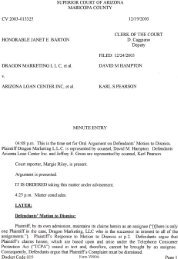Forcible Entry Techniques for Roll-Down Security Gates - American ...
Forcible Entry Techniques for Roll-Down Security Gates - American ...
Forcible Entry Techniques for Roll-Down Security Gates - American ...
Create successful ePaper yourself
Turn your PDF publications into a flip-book with our unique Google optimized e-Paper software.
● <strong>Forcible</strong> entry8910111312the “bill” of the lock breaker in thestaple of the lock, with the bottom ofthe bill resting on the lock body. Strikethe back of the bill with a sledgehammeror flathead ax, using as much <strong>for</strong>ceas necessary to separate the staple fromthe lock body (photo 9). Note that if thelock is attached to a chain, the duck billlock breaker may not develop enough<strong>for</strong>ce to break the lock because of theslack between the chain links and thestretching of the chain. Regular padlockscan be <strong>for</strong>ced in a similar mannerby driving the pike of a halligan barinto the space between the staple and the lock body. Thismethod is effective only if the diameter of the pike is largerthan the space between the staple and the lock body.As mentioned previously, you may encounter gates securedwith circular padlocks that are set in steel guards. It is quitedifficult to cut the staples on these locks because they arerecessed in the guards and protected by the pin and bracket.However, these locks can be defeated by using a saw to cutthe channel rails above and below the locks. Make the cuts atabout a 45-degree angle to <strong>for</strong>m a triangular-shaped section inthe channel rail; the narrow side of the cut should be towardthe outside of the channel rail (photo 10). After completing thecuts, drive the <strong>for</strong>k end of the halligan bar around the cut section.On thicker channel rails, you may have to use the flatheadax or sledgehammer to drive the <strong>for</strong>k around the cut section.After the <strong>for</strong>k is driven into the cut section, use the bar to bendthe cut section of the channel rail out and away from the gateto pull out the pin (photo 11). The pike end of the halligan canalso sometimes be placed between the lock and the guard andused to bend the cut section away from the gate.14You can defeat the <strong>American</strong> 2000, Master 6271, or Master736 hockey puck locks by using a saw to cut through the lockbody and guard, if present. For the <strong>American</strong> 2000, make a cutthrough the lock at a point just below and parallel with the“2000” lettering on the lock body. For the Master locks, makea cut three-quarters of the way up on the lock body from thekeyway. These cuts must be completely through the lock bodyto cut the staple (on the back side of the lock) and defeat thelock (photos 12-13). If no saw is available and the hockeypuck locks are not in guards, you can remove them with apipe wrench with an extended handle and twist the lock offthe bracket (photo 14). Hockey puck-type locks, especially theMaster Lock 736 version, can often be found along with guardplates securing the rear doors of commercial vans and worktrucks. For a fire in these types of vehicles, remove these locksby cutting them with a saw as described above.CUTTING STEEL SLAT GATESSteel slate gates may be recessed into a wall pocket or corner,which can restrict access to the locking devices, and there106 March 2012 FIRE ENGINEERING www.FireEngineering.com
















